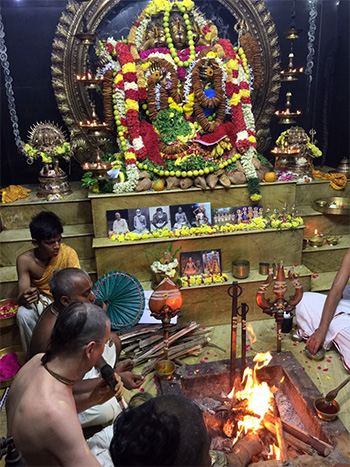Question: Why is Sri Radha’s name not mentioned in the Srimad Bhagavatam, and is worship of Sri Radha authorized in the scriptures? Also when did the Rasa Lila occur with the gopis?
Sri Radha’s name is not mentioned directly in Srimad Bhagavatam because Sri Shuka Muni, being the topmost rasika bhakta, would enter nirvikalpa samadhi by just once hearing the divine name of Sri Radha. Such a state of unconscious bliss would last for many days. Parikshit Maharaj had just seven days before his death, thus Shuka Muni avoided directly uttering the name of Radha, and instead hinted about Her by the word “aradhana”.
In other Puranas the descriptions of Sri Radha are given directy, especially in Sri Brahma-vaivarta Purana. The circumstances involving the recitation of these Puranas did not limit Shuka Muni to seven days, and thus the Rishis of Naimisharanya were able to accomodate Sri Shuka Muni’s entering nirvikalpa samadhi.
For those who have a preset conception, it is useless to cite evidence as to the divinity of Sri Radha. Any text that has the name of Sri Radha within it will be disregarded in favour of one’s own opinion. One will conclude that such texts are either of recent time periods (without actually having any proof in this regards), or that the particular verses will be called as interpolation (again without having proof in this regards either).
As far as the rasa-lila, it occurred when Lord Krishna was eight years of age, but to the gopis the Lord appears as a youth of sixteen years old. The Lord manifests His form according to the desire of the devotee. We find in Srimad Bhagavatam a description of the rasa dance. There it is mentioned that it lasted for the period of one kalpa, which in our calculations would be millions of years. The activities of the omnipotent Lord are inconceivable and beyond mundane logic. For the Lord it is not difficult to manipulate time and space, for they are His energies. Lord Krishna also expanded into numerous forms during the rasa lila, as well as in Dwaraka. Such topics cannot be understood by one who tries to judge Krishna in terms of material history.
Those who accept Krishna as an ordinary person will naturally have difficulty in accepting His supernatural activities. Whether it be Krishna’s marrying 16,108 wives, or Krishna’s lifting of Govardhana hill, neither can be accomodated in terms of material experience.
All of the great bhakti schools in India accept the transcendental existence of Radha and Krishna. Some schools may not give special significance to these forms of the Lord, but they certainly accept such worship as authorized. Vishnuswami, Ramanuja, Vallabhacharya, and Chaitanya all accept the transcendental position of Sri Radha. Though some think the worship of Radha is of recent origins, this is not the case. It is true that in recent times the importance of Radha worship has been especially stressed by Sri Chaitanya, but it is interesting to note that the “radha kalyana” festival is most common in South India, where there is little influence of Sri Chaitanya Mahaprabhu’s teachings. The madhurya-rasa (conjugal relationship with the Lord) is nothing new or sectarian. Great devotees such as Sri Andal have sung extensively about this madhurya-rasa.
Receive our daily email newsletter on Hinduism, Yoga, Meditation, Ayurveda and Natural Healing.







It is worthwhile mentioning that Sri Radha is mentioned not once but several times in Srimad Narayaneeyam of Narayana Bhattar, which closely follows Srimad Bhagavatam in narration.
I am so thankful to you for writing this article and clarifying this point. This question was haunting me for a long time as Sri Radha is the yoga maya Shakthi of Sri Krishna, so how can she be missed to be mentioned in Srimad Bhagawad? This article was helpful in answering this question.